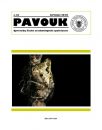The evolution and ecology of multiple antipredator defences 2023
- Authors
- Mgr. Jan Raška, prof. Mgr. Stanislav Pekár, Ph.D.
- Abstract
Prey seldom rely on a single type of antipredator defence, often using multiple defences to avoid predation. In many cases, selection in different contexts may favour the evolution of multiple defences in a prey. However, a prey may use multiple defences to protect itself during a single predator encounter. Such “defence portfolios” that defend prey against a single instance of predation are distributed across and within successive stages of the predation sequence (encounter, detection, identification, approach (attack), subjugation and consumption). We contend that at present, our understanding of defence portfolio evolution is incomplete, and seen from the fragmentary perspective of specific sensory systems (e.g., visual) or specific types of defences (especially aposematism). In this review, we aim to build a comprehensive framework for conceptualizing the evolution of multiple prey defences, beginning with hypotheses for the evolution of multiple defences in general, and defence portfolios in particular. We then examine idealized models of resource trade-offs and functional interactions between traits, along with evidence supporting them. We find that defence portfolios are constrained by resource allocation to other aspects of life history, as well as functional incompatibilities between different defences. We also find that selection is likely to favour combinations of defences that have synergistic effects on predator behaviour and prey survival. Next, we examine specific aspects of prey ecology, genetics and development, and predator cognition that modify the predictions of current hypotheses or introduce competing hypotheses. We outline schema for gathering data on the distribution of prey defences across species and geography, determining how multiple defences are produced, and testing the proximate mechanisms by which multiple prey defences impact predator behaviour. Adopting these approaches will strengthen our understanding of multiple defensive strategies.
Larvae of pyrrhocorid true bugs are not to spiders’ taste: putative Müllerian mimicry. 2020
- Authors
- Mgr. Jan Raška
- Abstract
- Adults and larvae of a true bug, Scantius aegyptius (Heteroptera: Pyrrhocoridae), closely resemble sympatric firebugs, Pyrrhocoris apterus, and probably form a mimetic relationship with the latter species. Scantius aegyptius adults, although producing a secretion atypical of true bugs, are to some extent chemically protected against predators. In this study, we analysed the composition and function of the larval secretion in S. aegyptius, and investigated the mimetic relationship between larvae of S. aegyptius and P. apterus. The main component of the larval secretion in S. aegyptius is 2-heptanol, a chemical not known to function in anti-predatory defence, followed by (E)-2-octenal, a common defensive chemical of true bugs. When larvae of both species were presented to jumping spiders (Evarcha arcuata), S. aegyptius was slightly less well protected than P. apterus, but the spiders behaved towards the two species in a similar way: they quickly learned to avoid the bugs, but usually attacked them again on the second day. The spiders also generalized their learned avoidance from one true bug species to the other (with only slight asymmetry favouring S. aegyptius), suggesting that the bugs’ mimetic relationship is most probably Müllerian, being advantageous to both species.
Do ladybird spiders really mimic ladybird beetles? 2019
- Authors
- Mgr. Jan Raška, prof. Mgr. Stanislav Pekár, Ph.D.
Perception of olfactory aposematic signals by jumping spiders. 2018
- Authors
- Mgr. Jan Raška
- Abstract
Studies of aposematism are mostly focused on visual aspects of warning signalization and based on experiments with avian predators. This study presents results of experiments with an arthropod predator, a jumping spider Evarcha arcuata (Araneae: Salticidae) and olfactory (i.e., noncontact chemical) aposematic signals. Spiders were presented with chemically protected firebug Pyrrhocoris apterus (Heteroptera: Pyrrhocoridae). After acquiring the negative experience with the bugs, the spiders were offered a choice between the firebug olfactory signal and a scentless control. Spiders actively avoided the firebug signal, showing that they are able to recognize an unprofitable prey by means of olfactory chemoreception. The results show that olfactory signals alone may function as effective means of aposematic signalization to spiders.
How variation in prey aposematic signals affects avoidance learning, generalization and memory of a salticid spider. 2017
- Authors
- Mgr. Jan Raška
Pavouk 40 (7/2016) 2016
- Authors
- Mgr. Aleš Jelínek, Mgr. Jan Dolanský, Jan Erhart, Mgr. Jan Raška, RNDr. Milan Řezáč, Ph.D., Mgr. Ondřej Machač, Ph.D., RNDr. Petr Dolejš, Ph.D., RNDr. Vlastimil Růžička, CSc.
- Abstract
Pavouci České republiky; Zavlečenci; Méně známé druhy pavouků Nuctenea silvicultrix; Nová pravidelná rubrika "Významné nálezy pavouků v ČR"; Významné nálezy pavouků z ČR I./Remarkable records of spiders from Czech Republic I.; Nález pavučenky Diplocephalus dentatus Tullgren, 1955; Poznámka k výskytu zápředníka Clubiona corticalis (Walckenaer, 1802); Klíšťata - neobvyklá kořist pavouků; Kořist larev hrabalek; Přírodní rozmanitost Vysočiny - výzva ke spolupráci; Zoodny České Budějovice 2016; Arachnologická exkurze 2016: Údolí Jihlavy a Oslavy; Česká bibliografie 2016; Britská bibliografie - The Newsletter 135; Pokyny pro autory
Reakce skákavky Evarcha arcuata na aposematické ploštice 2012
- Authors
- Mgr. Jan Raška
- Abstract
- Originalni ID: 1030
Reakce skákavky Evarcha arcuata na aposematické ploštice. 2011
- Authors
- Mgr. Jan Raška
- Abstract
- Originalni ID: 1003









